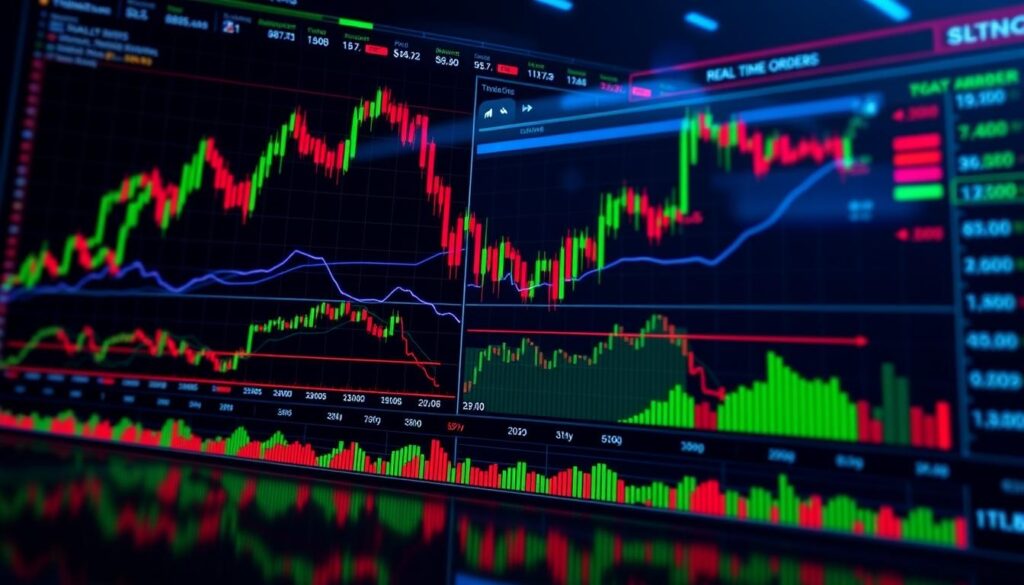Market depth is a crucial concept in trading that refers to a market’s ability to absorb relatively large market orders without significantly impacting the price of the security. It considers the overall level and breadth of open orders, bids, and offers, and usually refers to trading within an individual security. Understanding market depth is essential for traders seeking to enhance their decision-making process and gain valuable insights into liquidity, potential price movements, and overall market sentiment. For more information on trading and market analysis, visit trading market depth to learn more about the importance of market depth in trading.
Table of Contents
Key Takeaways
- Market depth refers to a market’s ability to absorb large orders without impacting the security’s price.
- Understanding market depth is crucial for traders to make informed decisions about buying or selling securities.
- Market depth is closely related to the volume of trade and associated liquidity.
- Real-time market depth data allows traders to profit from short-term price volatility.
- Traders can access market depth displays on trading platforms or purchase the data for a fee.
- Market depth shares a close relation to the volume of trade of a security and the associated liquidity, which is essential for trading.
- Market depth data enables traders to determine the directions of price movements of a security and make decisions based on pending orders.
What is Market Depth in Trading
Market depth refers to the ability to buy or sell a security at a stable price, regardless of the size of the trade. It is closely related to liquidity and volume within a security, but does not imply that every stock showing a high trade volume has good market depth. The order book, which consists of a list of pending orders to buy or sell at various price levels, is a key component of market depth.
A thorough liquidity analysis is essential to understanding market depth. By examining the bid-ask spread, traders can gain insights into the liquidity of a security. The bid-ask spread is the difference between the highest price a buyer is willing to pay and the lowest price a seller is willing to accept. A narrow bid-ask spread indicates high liquidity, while a wide spread indicates low liquidity.
Definition and Basic Concepts
Market depth is typically displayed as an electronic list of outstanding buy and sell orders, organized by price level and updated in real-time. This allows traders to assess the likely direction of an asset’s price and the number of shares that can be bought without impacting the price. Stocks with strong depth of market, such as Apple (AAPL), are often large-cap companies with high trading volumes, making it easier for traders to execute large orders.
Components of Market Depth
The components of market depth include the order book, bid and ask prices, and volume. Understanding these elements is crucial for grasping how market depth works and why it’s so important in trading. By analyzing the order book, traders can identify buying and selling opportunities based on supply and demand trends.
Importance in Trading Decisions
Market depth plays a critical role in trading decisions, as it provides valuable insights into potential price movements and market liquidity. Traders use depth of market data to profit from short-term price volatility by monitoring bid-ask spreads, current volume, and price levels. Real-time monitoring of depth of market allows traders to identify buying or selling opportunities and make informed decisions on when to enter or exit trades.
By incorporating market depth analysis into their trading strategy, traders can gain a competitive edge in the market. Whether trading stocks, futures, or other securities, understanding market depth is essential for making informed decisions and maximizing profits.
| Security | Market Depth | Liquidity |
|---|---|---|
| Apple (AAPL) | High | High |
| Small-cap stock | Low | Low |
Understanding the Order Book Structure
The order book is an electronic list of buy and sell orders organized by price level, providing market depth information. It displays the number of shares being bid or offered at each price point, which is essential for executing limit orders and market orders. The top of the order book shows the highest bid and lowest ask prices, crucial for traders to make informed decisions.
Order books are utilized by almost every exchange across assets like stocks, bonds, currencies, and cryptocurrencies. They provide real-time information on the quantity of orders bid on or offered at each price point, known as market depth. By analyzing the order book, traders can identify buying and selling trends, recognize support and resistance levels, and make informed decisions based on market activity.
Some key aspects of the order book include:
- Buy and sell orders for various assets, including equities, bonds, currencies, and cryptocurrencies
- Real-time information on the quantity of orders bid on or offered at each price point
- Cumulative size of liquidity for each side up to the top
- Ratio of buy orders to sell orders at various price levels
Understanding the order book structure is essential for traders to navigate the markets effectively. By analyzing the order book, traders can gain insights into market sentiment and potential price movements, making it a crucial tool for informed decision-making.
| Order Type | Description |
|---|---|
| Limit Orders | Orders to buy or sell at a specific price level |
| Market Orders | Orders to buy or sell at the current market price |
Bid and Ask Levels Explained
Understanding bid and ask levels is crucial in trading, as it provides insight into the market’s liquidity and volatility. The bid-ask spread, which is the difference between the bid and ask prices, can indicate the market’s depth. Market makers play a significant role in maintaining bid and ask levels, and their actions can influence the market depth.
The bid size and ask size represent the combined pending orders in the market across all investors, reflecting the current supply and demand for a stock. Level 1 stock market data typically includes the best bid price and its corresponding size, along with the best ask price and its corresponding size. Level 2 stock market data, also known as market depth, offers a more detailed view by showing multiple bid prices with their sizes and multiple ask prices with their sizes.
Bid Price Analysis
Bid price analysis involves examining the bid size and bid price to assess buying pressure. A high bid size can indicate strong support levels, while a low bid size can indicate weak support levels. Traders can use this information to make informed decisions about entering or exiting trades.
Ask Price Interpretation
Ask price interpretation involves examining the ask size and ask price to assess selling pressure. A high ask size can indicate strong resistance levels, while a low ask size can indicate weak resistance levels. Traders can use this information to identify potential areas of support and resistance.
Spread Significance
The bid-ask spread is a critical component of market depth, as it can indicate the market’s liquidity and volatility. A narrow bid-ask spread can indicate a liquid market, while a wide bid-ask spread can indicate a volatile market. Traders can use this information to adjust their trading strategies and manage risk.
By analyzing bid and ask levels, traders can gain a deeper understanding of market dynamics and make more informed trading decisions. Market makers, price levels, and bid-ask spread are all essential components of market depth, and understanding these concepts is crucial for successful trading.
Reading Market Depth Charts
Market depth charts provide a visual representation of the order book, making it easier for traders to quickly assess market conditions. These charts illustrate the supply and demand sides to show the amount of an asset that can be sold at a particular market price. By analyzing depth charts, traders can identify potential areas of support and resistance, gauge buying and selling pressure, and spot potential breakout or reversal points.
A visual analysis of market depth charts can help traders understand the balance between buying and selling activities, which impacts market prices. Price levels are a crucial aspect of market depth charts, as they show the amount of an asset that can be bought or sold at a particular price. Traders can use this information to make informed decisions about their trades.
Some key points to consider when reading market depth charts include:
- Buy and sell walls, which represent the cumulative value of buy or sell orders at a particular price level
- Depth chart tilt, which indicates asset liquidity levels and potential price movements
- Uneven tendencies in the depth chart, which can indicate market shortages or excessive liquidity
By analyzing these factors, traders can gain a deeper understanding of market conditions and make more informed decisions about their trades. Depth charts are a valuable tool for traders, providing a visual representation of the order book and helping them to identify potential trading opportunities.
Traders can use market depth charts to predict market directions and identify support and resistance levels. By combining visual analysis with other forms of analysis, such as technical indicators and fundamental analysis, traders can gain a more complete understanding of the market and make more informed decisions about their trades.
| Chart Type | Description |
|---|---|
| Ladder Chart | A type of depth chart that displays buy and sell orders in a ladder-like format |
| Heatmap Chart | A type of depth chart that displays buy and sell orders as a heatmap, with colors indicating the intensity of buying or selling activity |
Volume Analysis in Market Depth
Understanding trading volume is vital for investors to put price movements in context, as it measures market activity and participation. The total number of shares traded during a specific period is a crucial sign of market activity, helping investors distinguish between meaningful price moves and potential head fakes. Volume provides crucial clues about the strength of price movements – a rising stock with heavy volume suggests strong conviction from buyers, while a price increase on light volume suggests less confidence in the move.
Calculating trading volume involves counting the total number of shares or contracts traded over the assigned time frame. Traders use volume to interpret the strength and sustainability of market trends, including confirming trends, identifying reversals, and analyzing breakouts. Different volume situations traders might face include:
- Increasing volume and rising prices signaling a strong bullish signal
- Increasing volume and falling prices indicating bearish sentiment
- Falling volume and falling prices suggesting a weakening downtrend
- Falling volume and rising prices showing a potential weakening uptrend
Specialized volume indicators like on-balance volume (OBV), volume-weighted average price (VWAP), accumulation/distribution line (A/D Line), Chaikin money flow (CMF), price volume trend (PVT), and volume rate of change (VROC) help investors spot trends, confirm breakouts, and identify potential reversals. By analyzing trading volume and volume analysis, traders can gain a better understanding of market liquidity and make more informed investment decisions.
By incorporating volume analysis into their market depth analysis, traders can gain a more comprehensive understanding of market dynamics and make more informed investment decisions. This is especially important in today’s fast-paced markets, where market liquidity can change rapidly.
| Volume Indicator | Description |
|---|---|
| On-Balance Volume (OBV) | Measures buying and selling pressure |
| Volume-Weighted Average Price (VWAP) | Calculates the average price of a security based on volume |
| Accumulation/Distribution Line (A/D Line) | Measures the flow of money into or out of a security |
Using Market Depth for Price Prediction
Market depth analysis is a valuable tool for traders, providing insights into market sentiment and order flow. By examining the trend of the Depth of Market (DOM), traders can forecast whether the price will move up or down, determining the optimal timing to buy or sell.
Traders can use market depth data to identify imbalances in the order book, which may indicate upcoming price changes. Price prediction is a crucial aspect of trading, and market depth analysis can help traders make more informed decisions. The flow of orders can be used to gauge market sentiment, providing valuable insights into potential price movements.
Some key points to consider when using market depth for price prediction include:
- Identifying support and resistance levels through market depth analysis
- Monitoring changes in market depth over time to anticipate potential price movements
- Combining market depth analysis with other technical and fundamental factors to make more accurate predictions
By leveraging market depth data and analyzing order flow, traders can gain a competitive edge in the market. Real-time market depth data can provide trading professionals with opportunities to benefit from short-term price volatility, making it an essential tool for traders.
Liquidity Analysis Through Market Depth
Market liquidity is a critical factor in trading, and market depth provides valuable insights into the liquidity of a security. By analyzing market depth, traders can identify liquidity pools and assess the potential market impact of their trades. This information is essential in minimizing the risk of adverse price movements when executing large orders.
A deep market with sufficient liquidity will have a minimal impact on the price, even with large orders. On the other hand, a market with low liquidity will experience significant price movements, resulting in slippage. To avoid slippage, traders must understand the concept of liquidity pools and how to identify them in the order book.
Identifying Liquidity Pools
Liquidity pools are areas in the order book where there is a high concentration of buy or sell orders. These pools can provide liquidity to the market, reducing the risk of slippage. Traders can identify liquidity pools by analyzing the order book and looking for areas with a high volume of orders.
Understanding Market Impact
Market impact refers to the effect of a trade on the market price. A trade with high market impact will result in significant price movements, while a trade with low market impact will have minimal effect on the price. By analyzing market depth and identifying liquidity pools, traders can assess the potential market impact of their trades and adjust their strategies accordingly.
- Market depth: The total number of buy and sell orders at different price levels.
- Liquidity pools: Areas in the order book with a high concentration of buy or sell orders.
- Slippage: The difference between the expected price of a trade and the actual price.
By understanding these factors and analyzing market depth, traders can make informed decisions and minimize the risk of adverse price movements. Effective liquidity analysis is crucial in navigating today’s complex markets, where market liquidity, liquidity pools, and slippage can significantly impact trading outcomes.
Common Market Depth Patterns
Experienced traders recognize specific patterns in market depth data that signal potential price movements. These patterns can be identified in the order book and depth charts, providing valuable insights into future price action. By analyzing market patterns, traders can make informed decisions and stay ahead of the market.
Market depth analysis allows traders to predict support and resistance levels for market prices. When buying depth exceeds selling depth, it indicates strong demand at current prices, potentially driving prices higher. On the other hand, when selling depth exceeds buying depth, it indicates strong supply at current prices, potentially driving prices lower. Traders can use this information to identify trading signals and make profitable trades.
Identifying Bullish and Bearish Patterns
To identify bullish patterns, traders look for signs of strong demand, such as increasing buying depth and decreasing selling depth. Bearish patterns, on the other hand, are characterized by signs of strong supply, such as increasing selling depth and decreasing buying depth. By recognizing these patterns, traders can anticipate potential price movements and adjust their trading strategies accordingly.
Real-time market depth data allows traders to profit from short-term price volatility. By analyzing market depth charts, traders can identify areas of support and resistance, which can help them make informed trading decisions. Market depth charts also reveal the relationship between price movements and trader sentiment, providing valuable insights into market trends.
Traders can use market depth data to forecast potential price changes, gauge investor sentiment towards stocks, and supplement other technical indicators. By combining market depth analysis with other forms of technical analysis, traders can gain a more comprehensive understanding of the market and make more informed trading decisions. By recognizing common market depth patterns and understanding their implications, traders can improve their trading performance and achieve their financial goals.
Market Depth Trading Strategies
Effective trading strategies often rely on a combination of technical analysis, risk management, and a deep understanding of market dynamics. When it comes to market depth, traders can leverage this information to identify optimal entry and exit points, manage risk, and optimize trade execution. By analyzing the order book and identifying imbalances in buy and sell orders, traders can make more informed decisions about their trades.
Some common trading strategies that utilize market depth include scalping based on order book imbalances, trading breakouts confirmed by market depth, and using liquidity analysis for position sizing. These strategies can be adapted to different market conditions and trading styles, emphasizing the importance of backtesting and continuous refinement. Risk management is a critical component of any trading strategy, and market depth can provide valuable insights into potential risks and opportunities.
Traders can use market depth to identify potential support and resistance levels, which can inform their entry and exit points. By monitoring market depth throughout the day, traders can stay ahead of the curve and make more informed decisions about their trades. The following are some key considerations for trading strategies that utilize market depth:
- Identifying imbalances in buy and sell orders to inform trading decisions
- Using liquidity analysis to optimize position sizing and manage risk
- Adapting trading strategies to different market conditions and trading styles
- Continuously refining and backtesting trading strategies to ensure optimal performance
By incorporating market depth into their trading strategies, traders can gain a competitive edge and make more informed decisions about their trades. Whether using market depth to identify optimal entry and exit points or to manage risk, traders can benefit from the valuable insights provided by this information. As with any trading strategy, it’s essential to continuously refine and adapt approaches to ensure optimal performance and minimize risk.
Order Flow Analysis Techniques
Order flow analysis is a powerful technique used to understand market dynamics and identify trading signals. It involves analyzing the flow of orders in the market to anticipate short-term price movements. By examining the order flow, traders can gain insights into the balance between buying and selling pressure, which can help them make informed trading decisions.
Some key concepts in order flow analysis include:
- Aggressive buying and selling: This refers to the use of market orders to buy or sell securities at the current market price.
- Passive buying and selling: This involves using limit orders to buy or sell securities at a specified price.
- Order flow imbalance: This occurs when there is a significant difference between the number of buy and sell orders in the market.
Traders can use various tools and techniques to analyze order flow, including cluster charts and volume profiles. These tools provide a visual representation of the order flow and can help traders identify patterns and trends in the market. By combining order flow analysis with other forms of analysis, such as technical and fundamental analysis, traders can gain a more comprehensive understanding of the market and make more informed trading decisions.
- Improved trading decisions: By analyzing order flow, traders can gain insights into market dynamics and make more informed trading decisions.
- Enhanced risk management: Order flow analysis can help traders identify potential risks and opportunities in the market, allowing them to adjust their trading strategies accordingly.
- Increased trading efficiency: By using order flow analysis, traders can streamline their trading processes and reduce the time and effort required to make trading decisions.
| Order Flow Analysis Tool | Description |
|---|---|
| Cluster Charts | Visual representation of order flow |
| Volume Profiles | Analysis of trading volume at specific price levels |
Market Manipulation and Depth
Market depth data provides valuable insights into the supply and demand dynamics of a security, helping traders make informed decisions. However, it’s essential to be aware of potential market manipulation attempts, such as spoofing and layering, which can be observed through market depth data.
Traders can spot manipulation attempts by analyzing the order book and identifying suspicious patterns, such as abnormal trading volume or sudden price movements. Market manipulation can take many forms, including pump and dump schemes, insider trading, and spoofing. It’s crucial to understand these concepts to protect oneself from falling victim to manipulation.
To avoid market manipulation, traders can use various protection strategies, such as verifying the authenticity of large orders and identifying suspicious patterns in the order book. Regulatory efforts to combat market manipulation are also essential, and traders should be aware of these efforts to ensure a fair and transparent market.
Spotting Manipulation Attempts
- Analyzing the order book for suspicious patterns
- Identifying abnormal trading volume or sudden price movements
- Verifying the authenticity of large orders
Protection Strategies
By understanding market depth and being aware of potential market manipulation attempts, traders can make informed decisions and protect themselves from falling victim to manipulation. It’s essential to stay vigilant and adapt to changing market conditions to ensure success in the trading world.
Real-Time Market Depth Tools
Traders rely on trading platforms and market depth software to access real-time data and make informed decisions. These tools provide data visualization features, such as customizable depth charts and heat maps, to help traders understand market activities.
Some popular tools used by professional traders include Depth of Market (DOM) and Level II quotes, which aid in assessing market depth and identifying support and resistance levels. These tools offer features like order flow analysis, revealing supply and demand dynamics in forex pairs.
When choosing trading platforms and market depth software, traders should consider factors like customization options, data visualization capabilities, and compatibility with their trading style and budget. Some key features to look for include:
- Real-time data feeds
- Customizable charts and heat maps
- Order flow analysis tools
- Integration with technical analysis indicators
By leveraging these real-time market depth tools, traders can gain a deeper understanding of market dynamics and make more informed trading decisions. Whether using trading platforms or specialized market depth software, the key is to find the tools that best fit your trading needs and style, and to use them in conjunction with data visualization techniques to maximize their effectiveness.
Advanced Market Depth Analysis
Market depth analysis is crucial for traders to understand the liquidity and potential price movements of a security. By applying quantitative analysis methods, traders can gain insights into the order book and make informed decisions. Algorithmic trading software can automatically execute trades based on market depth data, making it an essential tool for traders.
Traders can use big data technologies to process and analyze vast amounts of market depth information in real-time. This allows them to identify patterns and trends that may not be visible through traditional analysis methods. By combining market depth analysis with other forms of analysis, such as technical and fundamental analysis, traders can gain a more comprehensive understanding of the market.
- Statistical analysis methods, such as time series analysis and correlation studies
- Machine learning applications, including pattern recognition and predictive modeling
- Heatmap analysis, which provides a visual representation of market depth data
By applying these methods, traders can stay ahead of the curve in an increasingly sophisticated trading landscape.
Common Mistakes to Avoid
When using market depth in trading decisions, it’s essential to be aware of common trading pitfalls that can impact your success. One of the primary concerns is over-relying on market depth data without considering other factors, such as broader market conditions and technical indicators.
Traders should also be cautious of emotional trading, making impulsive decisions based on market depth data alone. This can lead to poor decision-making and significant losses. To avoid this, it’s crucial to have a solid risk management plan in place, including setting stop-loss orders at strategic levels.
Some common mistakes to avoid include:
- Misinterpreting short-term fluctuations in market depth data
- Falling prey to false signals created by market manipulation
- Overtrading based on market depth alone during high volatility periods
By being aware of these potential pitfalls and taking a balanced approach to market depth analysis, traders can make more informed decisions and minimize their risk. It’s recommended to combine market depth analysis with other indicators, such as technical analysis and news updates, for a comprehensive view of the market sentiment.
Conclusion
As we conclude our journey through the fascinating world of market depth, it’s clear that this invaluable tool holds the key to unlocking trading success. By continuously learning and refining your market depth mastery, you’ll gain a profound understanding of the forces that shape the market, empowering you to make informed and profitable decisions.
Remember, market depth analysis is an ongoing process that requires diligence, patience, and a willingness to adapt to changing market conditions. Start by paper trading and honing your skills, then gradually apply these techniques to your real-world trading activities. Embrace the future of market depth analysis, as technological advancements and regulatory changes are sure to shape its evolution.
Ultimately, your journey to trading success lies in your hands. Utilize the resources and insights presented in this guide, and embark on a path of continuous growth and improvement. With market depth as your compass, you’ll navigate the markets with confidence, uncover opportunities, and ultimately achieve the trading success you desire.
FAQ
What is market depth in trading?
Market depth refers to the order book, which displays the buy and sell orders at various price levels. It provides insights into liquidity, potential price movements, and overall market sentiment.
What are the key components of market depth?
The key components of market depth include the order book, bid and ask prices, and trading volume.
Why is understanding the order book structure important in market depth analysis?
Understanding the order book structure is crucial for interpreting market depth data and identifying potential trading opportunities. It reveals how buy and sell orders are displayed at different price levels.
How can traders use bid and ask levels in market depth analysis?
Traders can use bid and ask levels to identify potential support and resistance levels, gauge buying and selling pressure, and make more informed trading decisions.
What information can traders extract from market depth charts?
Market depth charts provide a visual representation of the order book, allowing traders to quickly assess market conditions, identify potential areas of support and resistance, and spot potential breakout or reversal points.
How does volume analysis contribute to market depth analysis?
Volume analysis, including the use of volume indicators and volume profile analysis, can provide valuable insights into market dynamics and help traders confirm price movements within the context of market depth.
Can market depth data be used for price prediction?
Yes, traders can use market depth data to forecast potential price movements by identifying imbalances in the order book and analyzing the flow of orders to gauge market sentiment.
How can market depth be used to analyze liquidity?
Market depth data can help traders identify liquidity pools, assess the potential market impact of their trades, and minimize the risk of adverse price movements due to slippage.
What are some common market depth patterns that traders should be aware of?
Experienced traders often recognize patterns in market depth data, such as absorption, walls, and iceberg orders, that can signal potential price movements.
How can traders integrate market depth data into their trading strategies?
Traders can leverage market depth information for various trading strategies, such as scalping based on order book imbalances, trading breakouts confirmed by market depth, and using liquidity analysis for position sizing.
How can order flow analysis be combined with market depth data?
Order flow analysis, which focuses on reading order flow signals, can be integrated with market depth data to gain a more comprehensive understanding of market dynamics and make more informed trading decisions.
What are some common market manipulation techniques that can be observed through market depth data?
Traders should be aware of market manipulation techniques, such as spoofing and layering, that can be detected through anomalies in market depth data, and learn strategies to protect themselves from such manipulation attempts.
What are some of the advanced techniques and technologies used in market depth analysis?
Traders can explore advanced techniques like statistical analysis, machine learning algorithms, and big data technologies to process and analyze large amounts of market depth data in real-time and gain a competitive edge in their trading.
What are some common pitfalls to avoid when using market depth in trading decisions?
Traders should be cautious of overrelying on market depth data without considering other factors, misinterpreting short-term fluctuations, and making impulsive decisions based solely on market depth information.









